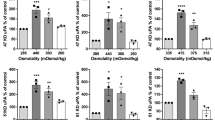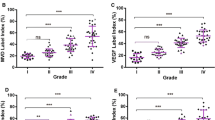Abstract
Metalloproteinases, inhibitors of metalloproteinases, plasminogen activators, inhibitors of plasminogen activators and cathepsins are thought to be involved in invasion by tumor cells. Glioblastoma multiforme is highly malignant and extremely refractory to therapy. One reason is because of its highly invasive nature within the nervous system. However, it remains unclear how invasion/dissemination of glioblastoma multiforme proceeds. In this study, we attempted to determine which proteinases were responsible for the invasion activity of human glioma cell linesin vitro. Nine human glioma cell lines (NHG1, NHG2, IN157, IN301, IN500, U251, U343, T98G and CCF-STTG1) derived from patients with glioma were grown in culture and used. We compared the invasion activity of glioma cell lines in a Matrigel invasion assay system, and formulated the activity as invasion index (%). Among the nine cell lines, IN157, IN500 and U343 showed less than 10% invasion activity (low group); NHGI, IN301 and CCF-STTG1 showed 10–25% activity (intermediate group); NHG2, U251 and T98G showed more than 30% activity (high group). Addition of an inhibitor of metalloproteinases, TIMP-1, to the assay system was found to significantly inhibit invasion activity of T98G cellsP<0.01). Northern blot analysis demonstrated expression of urokinase-type plasminogen activator (uPA), tissue-type PA (tPA) and PA inhibitor-1 (PAI-1) in some of the above cell lines. Cellular levels of PAs and their inhibitor mRNA, however, appeared not to be correlated with invasion activity in most glioma cell lines except for CCF-STTG1. Expression of 72 kDa type IV collagenase (MMP-2) was much lower in IN157, IN500 and U343 than other cell lines, whereas expression of TIMP-1 was much higher in IN500 than in other cell lines. Zymographic activity was found to be comparable to MMP-2 mRNA levels in all cell lines except for CCF-STTG1. Type IV collagenolytic activity was also comparable to invasion activity in nine cell lines. These observations suggest the role of type IV collagenase and its inhibitors in determining capacity for invasion by human gliomas. However, a comprehensive analysis bothin vitro andin vivo is required to confirm the role for this enzyme in glioma cell invasiveness.
Similar content being viewed by others
References
Woolley DE, 1984, Collagenolytic mechanisms in tumor cell invasion.Cancer Metastasis Rev,3, 361–72.
Reich R, Thompson EW, Iwamoto YY,et al. 1988, Effects of inhibitors of plasminogen activator, serine proteinases, and collagenase IV on the invasion of basement membranes by metastatic cells.Cancer Res,48, 3307–12.
Ossowski L, Clunie G, Masucci MT and Blasi F, 1991,In vivo paracrine interaction between urokinase and its receptor: effect on tumor cell invasion.J Cell Biol,115, 1107–1112.
Mackary AR, Corbitt RH, Hartzler JL and Thorgeirsson UP, 1990, Basement membrane type IV collagen degradation: evidence for the involvement of a proteolytic cascade independent of metalloproteinases.Cancer Res,50, 5997–6001.
Declerck YA, Perez N, Shimada HH,et al. 1992, Inhibition of invasion and metastasis in cells transfected with an inhibitor of metalloproteinases.Cancer Res,52, 701–8.
Turpeenniemi HT, Thorgeirsson UP, Hart IR, Grant SS and Liotta LA, 1985, Expression of collagenase IV (basement membrane collagenase) activity in murine tumor cell hybrids that differ in metastatic potential.JNCI,75, 99–103.
Nakajima M, Welch DR, Belloni PN and Nicolson GL, 1987, Degradation of basement membrane type IV collagen and lung subendothelial matrix by rat mammary adenocarcinoma cell clones of differing metastatic potentials.Cancer Res,47, 4869–76.
Baker MS, Bleakley P, Woodrow GC and Doe WF, 1990, Inhibition of cancer cell urokinase plasminogen activator by its specific inhibitor PAI-2 and subsequent effects on extracellular matrix degradation.Cancer Res,50, 4676–84.
Lyons RM, Gentry LE, Purchio AF and Moses HL, 1990, Mechanism of activation of latent recombinant transforming growth factor beta-1 by plasmin.J Cell Biol,110, 1361–7.
Giangaspero F and Burger PC, 1983, Correlations between cytologic composition and biologic behaviour in the glioblastoma multiforme. A postmortem study of 50 cases.Cancer,52, 2320–33.
Laerum OD, Bjerkvig R, Steinsvag SK and Steinsvag de RL, 1984, Invasiveness of primary brain tumors.Cancer Metastasis Rev,3, 223–36.
Lund JM, Engebraaten O, Bjerkvig R and Laerum OD, 1990, Invasive glioma cells in tissue culture.Anticancer Res,10, 1135–51.
DE Ridder L, Laerum OD, Mork SJ and Bigner DD, 1987, Invasiveness of human glioma cell linesin vitro: Relation to tumorigenicity in athymic mice.Acta Neuropathologica,72, 207–13.
Sitrin RG, Gyetko MR, Kole KL, McKeever P and Varani J, 1990, Expression of heterogeneous profiles of plasminogen activators and plasminogen activator inhibitors by human glioma lines.Cancer Res,50, 4957–61.
Sawaya R, Ramo OJ, Shi ML and Mandybur G, 1991, Biological significance of tissue plasminogen activator content in brain tumors.J Neurosurgery,74, 480–6.
Murphy P and Hart DA, 1992, Modulation of plasminogen activator and plasminogen activator inhibitor expression in the human U373 glioblastoma/astrocytoma cell line by inflammatory mediators.Exp Cell Res,198, 93–100.
Stetler-Stevenson W, Krutzsch HC and Liotta LA, 1989, Tissue inhibitor of metalloproteinases (TIMP-2). A new member of the metalloproteinase inhibitor family.J Biol Chem,264, 17374–8.
Vaithilingram IS, Stroude EC, Mcdonald W and Del Maesrto RF, 1991, General protease and collagenase (IV) activity in C6 astrocytoma cells, C6 spheroids and implanted C6 spheroids.J Neuro-Oncol,10, 203–12.
Abe T, Okamura K, Ono M,et al. 1993, Induction of vascular endothelial tubular morphogenesis by human glioma cells: a model system for tumor angiogenesis.J Clin Invest,92, 54–61.
Welch DR, Bisi JE, Miller BE,et al. 1991, Characterization of a highly invasive and spontaneously metastatic human malignant melanoma cell line.Int J Cancer,47, 227–37.
Mizoguchi H, Uchiumi T, Ono M, Kohno K and Kuwano M, 1990, Enhanced production of tissuetype plasminogen activator by estradiol in a novel type variant of human breast cancer MCF-7 cell line.Biochim Biophys Acta,1052, 475–82.
Mizoguchi H, Komiyama S, Matsui K,et al. 1991, The response to epidermal growth factor of human maxillary tumor cells in terms of tumor growth, invasion and expression of proteinase inhibitors.Int J Cancer,49, 738–43.
Nakayama Y, Kohno K, Nomura Y,et al. 1993, Enhanced invasive activity and decreased expression of tissue inhibitors of metalloproteinases by hepatocyte growth factor in human renal cancer cells.Cancer J,6, 213–19.
Mawatari M, Kohno K, Mizoguchi H,et al. 1989, Effects of tumor necrosis factor and epidermal growth factor on cell morphology, cell surface receptors, and the production of tissue inhibitor of metalloproteinases and IL-6 in human microvascular endothelial cells.J Immunol,143, 1619–27.
Mawatari M, Okamura K, Matsuda T,et al. 1991, Tumor necrosis factor and epidermal growth factor modulate migration of human microvascular endothelial cells and production of tissue-type plasminogen activator and its inhibitor.Exp Cell Res,192, 574–88.
Erkell LJ and Schirrmacher V, 1988, Quantitativein vivo assay for tumor cell invasion through extracellular matrix or into protein gels.Cancer Res,48, 6933–7.
Goldberg GI, Marmer BL, Grant GA,et al. 1989, Human 72-kilodalton type IV collagenase forms a complex with a tissue inhibitor of metalloproteases designated TIMP-2.Proc Natl Acad Sci USA,86, 8207–11.
Sato H, Kida Y, Mai M,et al. 1992, Expression of genes encoding type IV collagen-degrading metalloproteinases and tissue inhibitors of metalloproteinases in various human tumor cells.Oncogene,7, 77–83.
Gross JL, Behrens DL and Mullins DE, 1988, Plasminogen activator and inhibitor activity in human glioma cells and modulation by sodium butyrate.Cancer Res,48, 291–6.
Nielsen LS, Hansen JG, Skriver L,et al. 1982, Purification of zymogen to plasminogen activator from human glioblastoma cells by affinity chromatography with monoclonal antibody.Biochemistry,21, 6410–15.
Paganetti PA, Caroni P and Schwab ME, 1988, Glioblastoma infiltration into central nervous system tissue in vitro: involvement of a metalloprotease.J Cell Biol,107, 2281–91.
Mareel MM, 1983, Invasionin vitro. Methods of analysis.Cancer Metastasis Rev,2, 201–18.
Moscatelli D and Rifkin DB, 1988, Membrane and matrix localization of proteinases: a common theme in tumor cell invasion and angiogenesis.Biochim Biophys Acta,948, 67–85.
Laiho M and Keski OLJ, 1990, Growth factors in the regulation of pericellular proteolysis: a review.Cancer Res,49, 2533–53.
Haward EW, Bullen EC and Banda MJ, 1991, Preferential inhibition of 72 and 92 kDa gelatinases by tissue inhibitor of metalloproteinases-2.J Biol Chem,266, 13070–5.
Author information
Authors and Affiliations
Rights and permissions
About this article
Cite this article
Abe, T., Mori, T., Kohno, K. et al. Expression of 72 kDa type IV collagenase and invasion activity of human glioma cells. Clin Exp Metast 12, 296–304 (1994). https://doi.org/10.1007/BF01753836
Received:
Accepted:
Issue Date:
DOI: https://doi.org/10.1007/BF01753836




